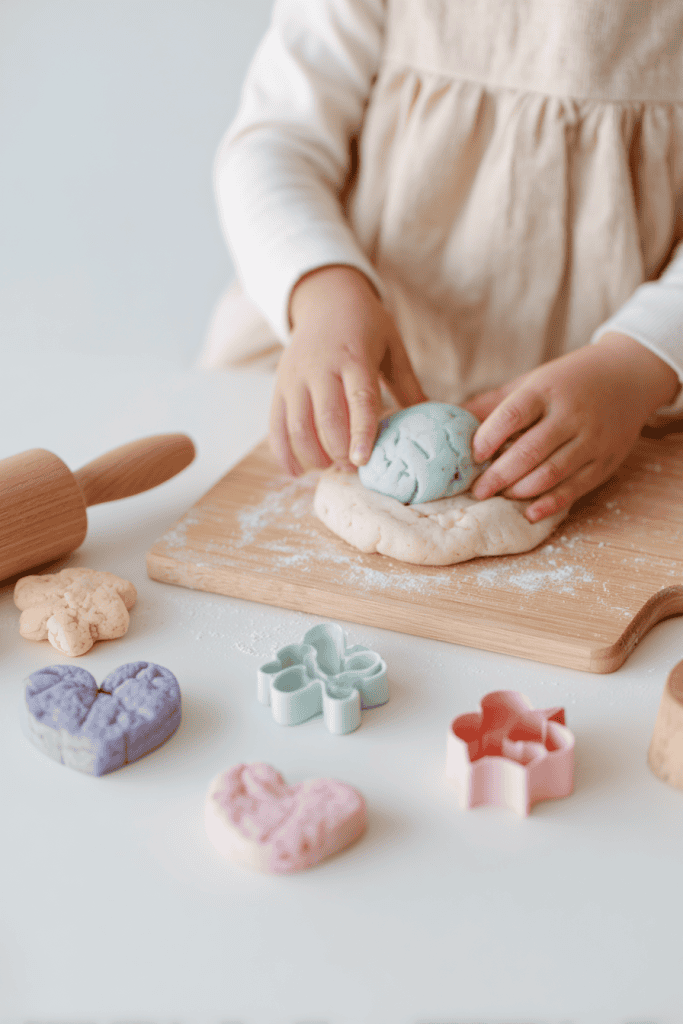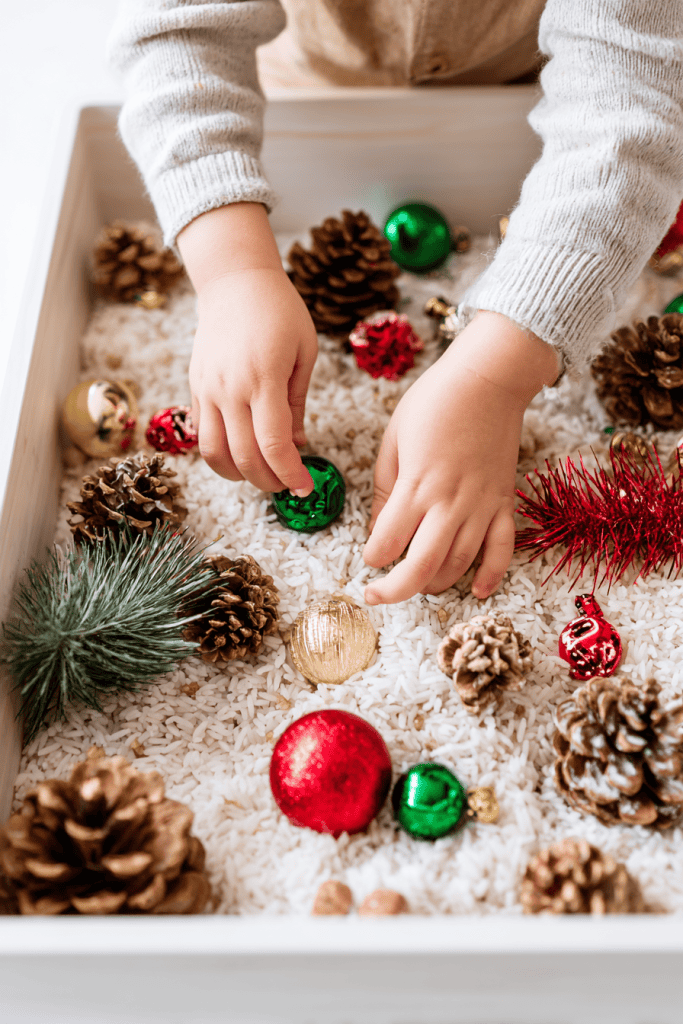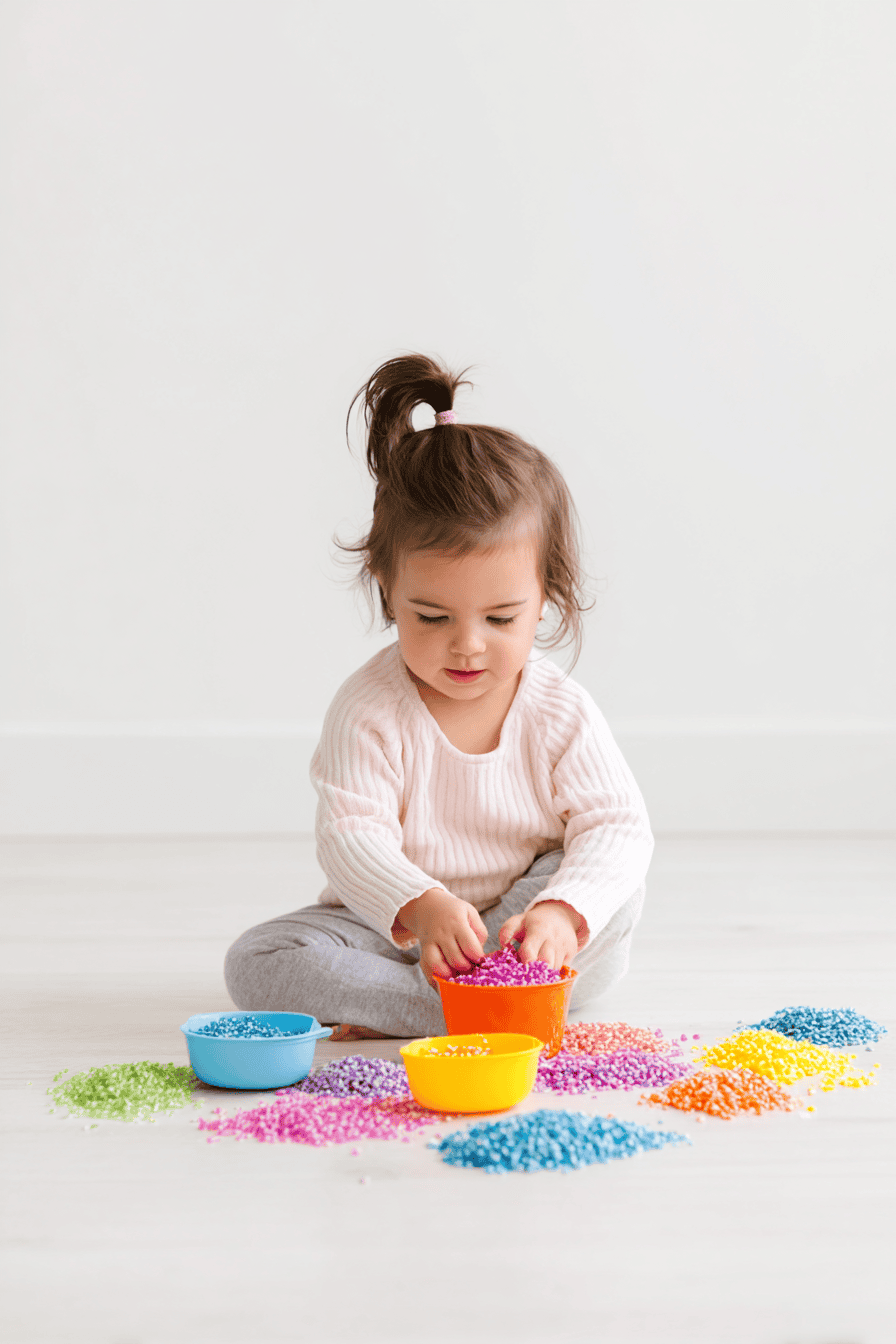Toddlers learn about the world by touching, smelling, listening, watching, and tasting.
Every moment of play is a chance to build confidence, strengthen focus, and grow new skills. Sensory activities make this natural process intentional.
They invite children to explore with curiosity while giving caregivers simple ways to support development.
The best part is that everyday items (water, soil, fabric scraps, or kitchen tools) can be transformed into rich learning experiences.
With a little setup, you create opportunities that spark creativity, encourage independence, and make playtime meaningful.
In this article, you’ll find 15 fun sensory activities for toddlers. Each one is practical, easy to adapt, and designed to nurture both skill-building and joy.
What Is Sensory Play (and Why It Matters?)
Sensory play is any activity that invites a child to engage their senses – touch, sight, sound, smell, and sometimes taste in safe ways.
It helps toddlers process the world around them by giving shape, texture, and rhythm to their experiences.
When toddlers pour water, squish playdough, or sort leaves by color, they are doing more than keeping busy. They are strengthening motor skills, learning focus, and building the language to describe what they notice.
These small moments of discovery create the foundation for problem-solving, creativity, and calm self-regulation.
What makes sensory play so powerful is its simplicity. A handful of beans, a tray of bubbles, or a collection of textured fabrics can turn an ordinary afternoon into a meaningful learning experience.
And because it’s easy to set up with everyday items, sensory play fits naturally into family life without extra pressure.
If you’re looking for more creative ideas to keep kids engaged, try exploring fun Sunday School crafts or festive fall craft activities that tap into similar hands-on learning.
15 Fun Sensory Activities for Toddlers
Sensory play is most effective when it feels natural and joyful.
These ideas use simple items you likely already have at home, so you can focus on being present instead of preparing elaborate setups.
1. Water Play Station

Fill a shallow tub or basin with clean water and offer safe items like measuring cups, small ladles, and spoons.
The act of scooping, pouring, and watching water flow helps toddlers develop hand-eye coordination while exploring cause and effect.
You can add floating objects (like silicone cupcake liners or plastic lids) for extra curiosity.
For toddlers who enjoy repetition, this activity provides a calming rhythm as they pour water again and again.
2. Kitchen Treasure Hunt

Choose a selection of pantry staples such as dried beans, pasta, or rice, and place them in small containers for your toddler to explore.
Offer a scoop or a wooden spoon and let them move items from one bowl to another.
The variety of shapes, sounds, and textures encourages sensory exploration while introducing early concepts of sorting and measuring.
To extend the activity, ask your toddler to find “the smoothest item” or “the longest piece,” turning play into an early language-building exercise.
3. Soft & Crunchy Basket

Gather a mix of safe, contrasting textures and place them in a basket.
Think of items like a soft cotton cloth, a crinkly piece of parchment paper, a natural sponge, and a small wooden block.
Encourage your toddler to explore each one with their hands, feet, or even cheeks.
The goal is not just touch, but noticing differences: smooth versus rough, firm versus flexible.
This activity strengthens sensory awareness and gives toddlers language for describing textures in their daily lives.
4. Garden Dig Bin

Fill a shallow container with potting soil or clean sand and add a few safe scoops, cups, or small shovels.
Bury natural treasures such as pinecones, smooth stones, or sturdy leaves for your toddler to uncover.
Digging and sifting through the soil builds fine motor strength and introduces basic problem-solving as they search and discover.
This activity is especially meaningful outdoors, where the sounds of birds and the feel of fresh air add another layer of sensory experience.
5. Leaf & Flower Sorting

Collect a small assortment of leaves and petals during a walk or from your garden.
Lay them out on a tray or low table and invite your toddler to sort them by size, color, or shape.
They may choose to crinkle a dry leaf, smell a flower, or line them up in rows.
This simple activity blends nature exploration with early math concepts – matching, categorizing, and comparing.
It also encourages close observation, helping toddlers slow down and notice the world around them.
6. Mud Kitchen Creations

Set up a dedicated spot outdoors with bowls, spoons, and old cups, and let your toddler mix soil, water, and nature finds to create “recipes.”
They might stir muddy soup, decorate with grass clippings, or fill containers with water and stones.
The tactile mix of textures (gritty, smooth, and wet) offers a rich sensory experience.
This type of imaginative play builds both creativity and resilience, giving toddlers the freedom to experiment without rigid instructions.
7. Homemade Playdough

Mix flour, salt, and water (with a touch of oil) into a soft dough, or use a favorite safe recipe.
Once ready, offer rolling pins, cookie cutters, or even just your toddler’s hands.
The act of pressing, squishing, and shaping strengthens finger muscles and hand coordination – important skills for later writing.
You can lightly scent the dough with cinnamon or vanilla for an added sensory layer.
Because the dough is pliable and forgiving, toddlers can explore freely without worrying about “mistakes.”
8. Finger Painting with Toddler-Safe Paint

Spread a sheet of paper on a tray or tape it to the table, then place a small amount of washable, non-toxic paint for your toddler to explore with their hands.
Encourage them to smear, swirl, and blend colors, focusing on the feel of the paint rather than the outcome.
This activity introduces color mixing, builds creativity, and gives children confidence in self-expression.
For added variety, offer textured tools such as a sponge or a plastic fork to drag across the paint.
9. Sensory Collage

Provide a piece of cardboard or thick paper as a base and offer safe materials with different textures – scraps of fabric, bits of ribbon, smooth paper, or dried leaves.
Let your toddler glue pieces however they wish, layering materials and feeling the contrast under their fingers.
The process allows them to experiment with design while noticing how rough, soft, or bumpy each item feels.
This open-ended project blends sensory discovery with early art, creating something unique each time.
10. Bubble Bin

Fill a shallow container with warm water and add a small amount of mild soap to create bubbles.
Provide safe tools like whisks, scoops, or cups for your toddler to stir, scoop, and catch the bubbles.
Watching bubbles form, pop, and float adds a layer of visual delight while encouraging hand-eye coordination.
The gentle sound of bubbles popping and the soft texture under their hands make this a calming, engaging experience that can hold their focus for quite some time.
11. Calm Glitter Jar

Use a clear plastic bottle with a tight lid, fill it with water, and add a pinch of glitter or sequins.
Seal securely and invite your toddler to shake the jar, then watch the sparkles slowly settle.
This activity helps toddlers explore the concepts of motion and stillness while offering a soothing visual effect.
Beyond the sensory experience, it introduces the rhythm of cause and effect – what happens when the jar is shaken versus when it is still.
12. Barefoot Texture Path

Lay out a row of safe household items (such as a folded towel, a woven rug, a soft blanket, and a rubber mat) and invite your toddler to walk across them barefoot.
Each step gives a new sensation: soft, firm, bumpy, or springy.
This playful pathway encourages body awareness and balance while helping toddlers become more comfortable with different tactile experiences.
For variety, you can rearrange the order or add natural elements like smooth stones or grass mats.
13. Frozen Toy Rescue

Place small, safe toys (like plastic animals or silicone shapes) inside an ice cube tray or freezer-safe container with water.
Once frozen, give your toddler a safe tool such as a spoon or a cup of warm water to help “rescue” the toys.
The shifting sensations of cold, smooth ice melting into water make this activity especially engaging.
It teaches patience, problem-solving, and the thrill of discovery as each hidden object emerges.
14. Color Sorting with Seasonal Objects

Offer a small collection of natural or household items in a variety of colors – autumn leaves, seashells, wooden blocks, or felt pieces.
Place them in a basket and invite your toddler to sort them into groups by color.
The activity sharpens observation skills and builds early math foundations such as categorizing and grouping.
By using seasonal objects, you also connect play to the rhythms of the year, making it easy to refresh and repeat in new ways.
15. Holiday Sensory Bin

Create a themed bin using safe, seasonal items – jingle bells, fabric ribbons, pinecones, or felt hearts, depending on the celebration.
Fill a shallow container with rice or shredded paper and let your toddler scoop, shake, and arrange the items.
The sounds, textures, and colors spark festive excitement while also encouraging creativity and fine motor exploration.
Because the items can be swapped out for different holidays, this sensory bin becomes a flexible tradition that grows with your child.
Tips for Successful Sensory Play
Sensory play works best when it feels natural and manageable for both you and your toddler.
A few thoughtful adjustments can make these activities easier to set up, smoother to enjoy, and more meaningful for your child.
- Keep it short and consistent. Toddlers don’t need long sessions to benefit. Five to fifteen minutes is often enough to spark discovery and joy.
- Offer simple choices. Too many materials can overwhelm. A few well-chosen items invite curiosity without creating distraction.
- Stay nearby with calm presence. Your attention and encouragement matter more than correcting or directing. Let your toddler lead, while you support.
- Make cleanup part of the play. Place a tray, towel, or mat under activities. This helps contain the mess and gives toddlers a sense of order when playtime ends.
- Follow your toddler’s cues. If they want to repeat an activity every day, that’s valuable practice. If they move on quickly, that’s learning too.
- Rotate materials. Keep the experience fresh by swapping items – a different bowl, a new texture, or a seasonal element can rekindle interest.
These simple practices keep sensory play relaxed and approachable, ensuring it becomes a regular, enjoyable part of your routine.
Make Sensory Play Part of Everyday Life
The real power of sensory play comes from its simplicity. You just need a few minutes, a curious toddler, and materials you already have at home.
Over time, these small experiences build focus, creativity, and confidence in ways that feel natural and joyful.
Start with one or two activities that fit your day, and let them become part of your routine.
Each scoop of water, each swirl of paint, or each texture explored is a step toward growth and connection.
Which activity will you try first with your toddler? Share in the comments below – I’d love to gather more ideas together.
FAQs
What age is best to start sensory play?
Sensory play can begin as early as infancy with safe, simple experiences like touching fabric or listening to music. For toddlers, activities that involve scooping, pouring, and sorting are ideal, as they align with developing motor and problem-solving skills.
How often should toddlers do sensory play?
A few minutes of sensory play each day is enough to be beneficial. Consistency is more important than length, and short daily sessions build focus, creativity, and confidence over time.
Do sensory activities always have to be messy?
Not at all. Many sensory experiences are tidy, such as sorting fabrics, walking on textured mats, or swirling a glitter jar. Messy play can be wonderful, but it’s not required for the benefits to shine through.
What are the main benefits of sensory play?
Sensory play strengthens motor skills, supports language development, improves focus, and helps children process their emotions. It’s a powerful way to combine learning with play in everyday life.
Can I create sensory play with items I already have at home?
Yes. Most sensory play can be set up with simple materials like rice, spoons, towels, water, or natural items from outdoors. No need for expensive toys – everyday objects can become meaningful tools for learning.

